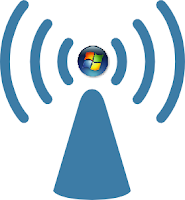With the proliferation of wireless networks, it is becoming more and more likely that if you live in upwards of a fairly well a populated area, you are going to have problems with your wireless LAN.
Problems that are likely to include random wireless drops, undetectable or uncontactable wireless networks, data throughput problems, etc etc.
The question is - what can be done to try and get to the bottom of these problems?
Perhaps the best place to start is to run a single command line tool to find out as much information as we can about:
- Wireless adapter model
- Adapter card driver details
- Configured wireless LAN profile(s)
- Full details of wireless networks currently visible
Historically to get this level of information, you would need to look in several places (device manager, wireless networking info) and install 3rd party applications such as NetStumbler etc.
OK, so how do you get all this info from the single command? Easy peasy.
- Click Start (aka Windows Orb) and enter cmd into the text box and hit enter to open a command prompt
- Into the command prompt window, enter the command:
- This will run the command and pipe the output of the command into the file wireless.txt for easy reading
- Still in the command prompt window, run
- This will open the output from the "netsh wlan show all" command in notepad
netsh wlan show all >wireless.txt
notepad wireless.txt
=======================================================================etc etc etc!
============================== SHOW DRIVERS ===========================
=======================================================================
Interface name: Wireless Network Connection
Driver : Intel(R) PRO/Wireless 2200BG Network Connection
Vendor : Intel Corporation
Provider : Intel
Date : Wed 19/12/2007
Version : 9.0.4.39
INF file : C:\Windows\INF\oem1.inf
Files : 3 total
C:\Windows\system32\DRIVERS\w29n51.sys
C:\Windows\system32\Netw2c32.dll
C:\Windows\system32\Netw2r32.dll
Type : Legacy Wi-Fi Driver
Radio types supported : 802.11g 802.11b
FIPS 140-2 mode supported : No
Hosted network supported : No
Authentication and cipher supported in infrastructure mode:
Open None
Open WEP
Shared None
Shared WEP
WPA-Enterprise TKIP
WPA-Enterprise CCMP
WPA-Personal TKIP
WPA-Personal CCMP
WPA2-Enterprise TKIP
WPA2-Enterprise CCMP
WPA2-Personal TKIP
WPA2-Personal CCMP
Authentication and cipher supported in ad-hoc mode:
Open WEP
Shared WEP
Open None
Shared None
=======================================================================
============================= SHOW INTERFACES =========================
=======================================================================
Troubleshooting:
Channels in "SHOW NETWORKS MODE=BSSID" section
Find your wireless LAN and compare this to the channel details of the other wireless networks detailed in the results file. If your wireless network is using the same channel as someone else's then change your wireless access point or router to use a different wireless channel.
Signal strength in "SHOW NETWORKS MODE=BSSID" section
Yes I know the Windows 7 GUI gives you signal strength (and that's about all), but this method is more accurate. Is the strength any good? With a higher signal strength, is the wireless connection more stable?
Some more advance troubleshooting includes:
Driver in "SHOW DRIVERS" section
In my case:
Driver : Intel(R) PRO/Wireless 2200BG Network ConnectionArmed with this info, I can hit Intel's website and see if there is a newer version driver available and update.
Vendor : Intel Corporation
Provider : Intel
Date : Wed 19/12/2007
Version : 9.0.4.39
Alternatively, I could go to the Windows Update Catalogue and search for MS approved driver updates or hotfixes. See here for how to use the catalogue.
Basic Rate and Other Rate in "SHOW NETWORKS MODE=BSSID" section
Try configuring your wireless card via device manager to run at one of the basic rates listed. Does this make any difference? Trial and error to see how fast you can go whilst remaining stable.
Conclusion
As we have seen, by running one simple command you can grab all sorts of valuable wireless information and have a real good stab at fixing wireless networking woes.
If all else fails, then there is always Ethernet over power!
- Chris









